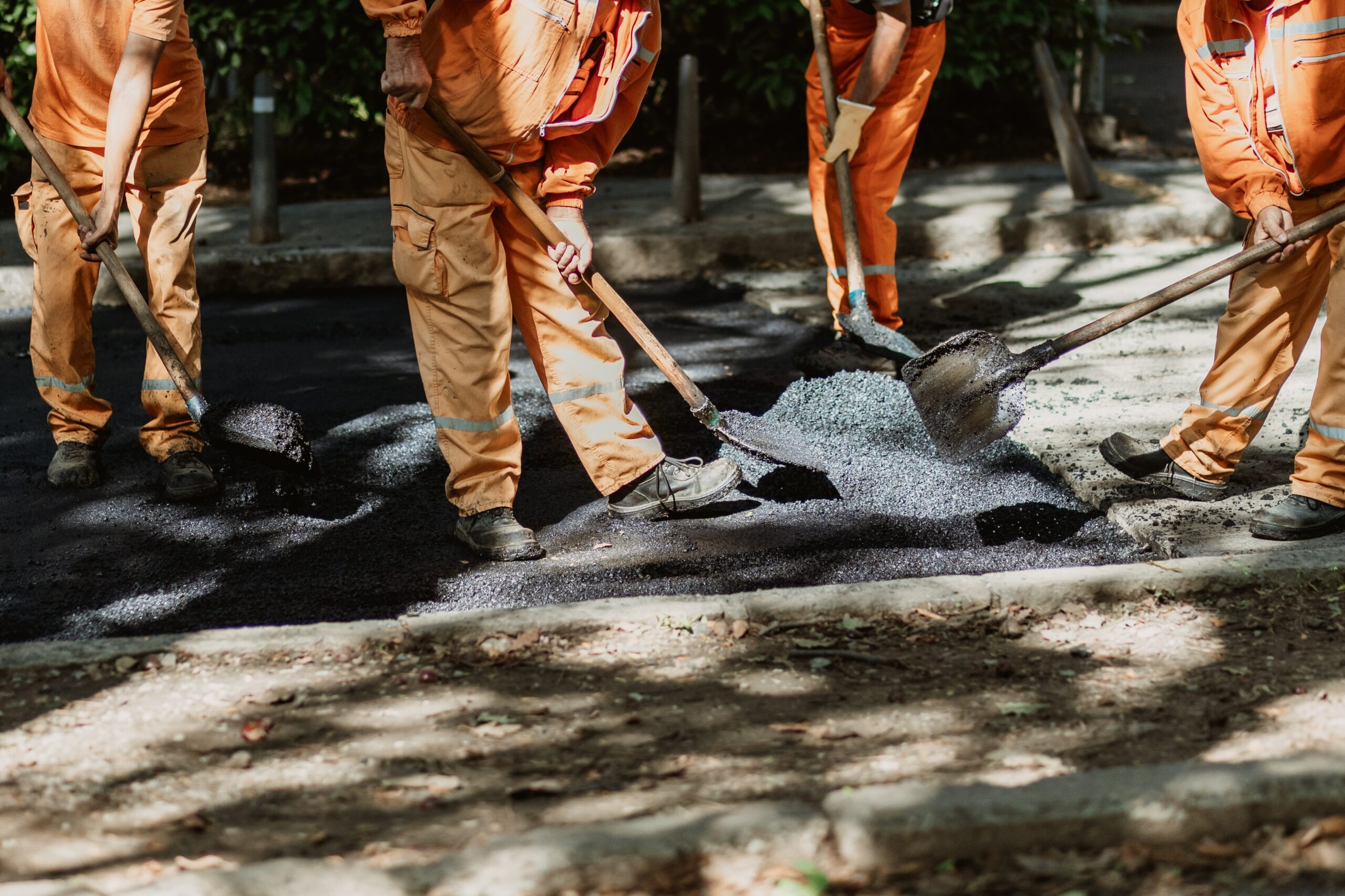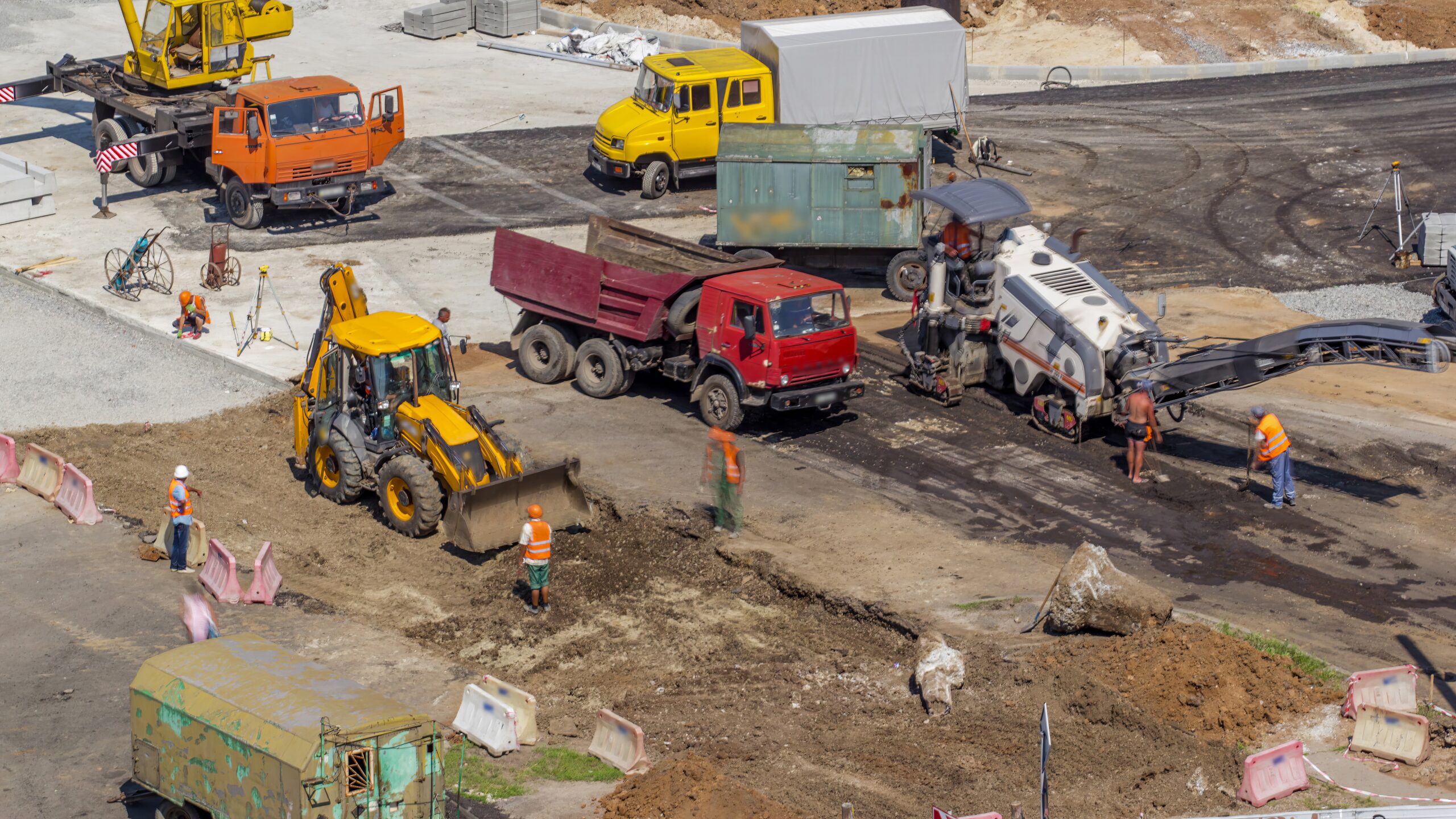
Potholes don’t just damage vehicles; they’re visible symptoms of deeper pavement failure. Behind every pothole is a series of preventable issues: water infiltration, base erosion, and structural fatigue. If you’re managing asphalt surfaces, understanding how potholes form is critical. It’s not just about patching holes; it’s about identifying risks early, preventing costly repairs, and planning overlay vs replace at the right time. This guide explores the real causes of potholes, seasonal impacts, and practical methods to fix asphalt damage. Whether you oversee a commercial lot or a municipal road, this resource will help you make informed, proactive decisions to protect your asphalt investment.
What Causes Potholes?
The formation of a pothole begins below the surface of your asphalt. While they may look like shallow holes at first, their root cause is often hidden deep within the pavement structure. The process involves multiple contributing factors working together over time.
1. Water Infiltration
Water is the leading contributor to pothole development. When it seeps through small surface cracks, it reaches the lower layers of the pavement. If the sub-base or base layer is compromised, the entire surface becomes vulnerable to collapse.
2. Freeze-Thaw Cycles
In colder climates, trapped water in the pavement freezes and expands. This pushes the pavement upward, weakening its structure. When the ice melts, it leaves behind gaps or voids beneath the surface. Repeated cycles make the problem worse.
3. Heavy Traffic Loads
Asphalt is designed to withstand a certain amount of stress. When roads experience frequent heavy traffic; like delivery trucks, construction equipment, or buses; it accelerates the breakdown of the pavement, especially if the sub-base is already weakened. Traffic stress is one of the major asphalt damage factors.
4. Poor Drainage
Standing water on pavement is a red flag. Without proper drainage, water stays on the surface or seeps down into the lower layers, softening the base and setting the stage for pothole formation.
5. UV Damage and Oxidation
Over time, UV rays break down the binder in asphalt, making the surface brittle. This leads to small cracks that let water in. A dry, cracked surface is more prone to damage from external stress.
6. Substandard Construction
Improper installation or use of low-quality materials can lead to premature failure. Thin pavement layers, lack of proper compaction, or an unstable sub-base can all lead to early pothole formation.
Why Experienced Asphalt Coating Specialists Make a Difference
Your pavement is a long-term investment. Protecting it requires the expertise of professionals who understand every stage of its lifecycle; from installation to repair and maintenance.
Asphalt Coating Company brings decades of experience in preventive asphalt care, structural evaluations, and high-performance repair services. We use time-tested methods and proven materials to ensure that your surface stays safe, functional, and visually appealing for years to come.
- Expert evaluations and tailored maintenance plans
- Certified crews with advanced equipment
- Commitment to long-term durability, not short-term fixes
- Solutions based on surface condition, environment, and traffic load
Early Signs That a Pothole is Developing
Potholes never start as potholes. They evolve gradually. Being able to identify the early warning signs can help in scheduling timely maintenance, which saves time, money, and infrastructure.
- Alligator Cracking
A pattern of interconnected cracks resembling reptile skin. It usually indicates structural weakness in the base layer.
- Longitudinal and Transverse Cracks
Cracks that run either parallel or perpendicular to traffic. These are common entry points for water infiltration.
- Discoloration or Surface Graying
Asphalt that fades from deep black to gray has likely undergone oxidation. This is an early stage of surface degradation.
- Water Pooling
If water collects after rain, there’s likely an issue with slope, grading, or drainage. These areas are prime spots for future potholes.
- Soft Spots or Dips
These suggest that the base material underneath the surface may have shifted or eroded. Soft spots are often the final stage before collapse.
How Weather Affects Pothole Formation
Weather patterns have a significant impact on the condition of asphalt surfaces. While freeze-thaw cycles are commonly blamed, each season presents its own risks.
Spring
- Melting snow and consistent rainfall increase water infiltration.
- Reveals hidden cracks formed over winter.
- Ideal time for early-season repairs.
Summer
- High heat accelerates oxidation.
- Expands minor cracks into larger fissures.
- Ideal time for crack sealing and sealcoating.
Fall
- Opportunity to reinforce the pavement before winter.
- Address drainage issues and seal vulnerable cracks.
- Sealcoating during early fall helps block UV rays and water damage.
Winter
- Freeze-thaw cycles are most active.
- Emergency cold patching is sometimes required.
- Avoid long-term fixes during sub-zero conditions.
Long-Term Consequences of Ignoring Potholes
Potholes are often dismissed as minor surface issues; but the reality is far more serious. When left unrepaired, potholes compromise the integrity of the entire pavement structure. Their continued presence accelerates deterioration, affects surrounding infrastructure, and significantly increases future repair costs. Understanding these long-term effects is essential for anyone managing asphalt surfaces.
Vehicle Damage Becomes Frequent and Costly
One of the most immediate and visible effects of potholes is damage to vehicles. Each time a car drives over a pothole, especially at higher speeds, it subjects the vehicle to unnecessary impact. Over time, this results in:
- Wheel misalignment, which reduces tire life and handling safety
- Tire punctures or blowouts, which increase accident risk
- Suspension damage, particularly to struts, shocks, and ball joints
- Cracked rims and bent wheels, leading to expensive replacements
This damage isn’t limited to high-traffic roads; parking lots, driveways, and access lanes with unchecked potholes also pose ongoing risks to vehicle integrity.
Increased Pedestrian Safety Hazards
Potholes aren’t just a danger to drivers; they also create dangerous trip hazards for pedestrians. This is especially critical in commercial and municipal settings, where public foot traffic is common. Uneven pavement or water-filled depressions can cause:
- Slips, trips, and falls
- Ankle sprains or fractures
- Injuries that may lead to lawsuits and liability claims
In areas with poor lighting, potholes become even more difficult to spot, making nighttime accidents far more likely.
Escalating Property and Infrastructure Damage
The effects of potholes go beyond the pavement surface. Once a pothole forms, water begins to seep into the underlying layers of the pavement and the surrounding property. This can lead to:
- Erosion of the sub-base, weakening structural support
- Flooding of nearby landscaping or utility boxes
- Damage to foundations, sidewalks, or adjacent buildings
- Compromised drainage systems due to clogged pathways or water redirection
Over time, the entire paved area becomes unstable, leading to widespread structural problems that can require full-scale reconstruction.
Legal and Financial Liability Exposure
For property owners and businesses, potholes pose serious legal risks. If someone is injured; or if a vehicle is damaged; due to an unrepaired pothole, the property owner may be held legally responsible. Consequences may include:
- Personal injury lawsuits
- Insurance claims and premium increases
- Violations of local or ADA accessibility codes
- Reputation damage for failing to maintain a safe environment
For commercial establishments, this can negatively affect customer trust and even lead to temporary business closures.
Accelerated Pavement Failure and Expensive Reconstruction
Ignoring even small potholes sets off a chain reaction of damage beneath the surface. As water seeps in and freeze-thaw cycles repeat, cracks widen and the surrounding pavement becomes unstable. Eventually, this leads to:
- Spiderweb or alligator cracking across large surface areas
- Widespread raveling and delamination
- Loss of structural integrity in the sub-base
- The need for full-depth patching, resurfacing, or complete replacement
What begins as a small, easily repairable depression can turn into a major infrastructure failure within a single season; especially in areas with frequent temperature fluctuations or heavy traffic.
Loss of Investment and Reduced Pavement Lifespan
Asphalt surfaces are built to last; typically 15 to 25 years with proper care. But potholes drastically shorten this lifespan when left unaddressed. They allow moisture to penetrate, break down the binder, and create internal voids. Without timely maintenance, the entire investment is compromised, and you may find yourself paying for premature reconstruction much sooner than expected.
Negative Impact on Property Value and Aesthetics
A deteriorated surface filled with potholes sends a strong visual message: neglect. For commercial properties, this affects curb appeal, customer experience, and overall property value. For municipal infrastructure, it reflects poorly on maintenance standards and community investment. Long-term neglect can lead to:
- Decreased property appraisal values
- Tenant dissatisfaction or reduced occupancy in commercial units
- Poor public perception and complaints from residents or customers
A well-maintained surface, by contrast, improves both function and first impressions.
Best Practices for Pothole Prevention
Effective pothole prevention requires a long-term maintenance plan, routine inspections, and timely interventions.
Regular Pavement Inspections
Visual inspections twice a year help catch issues early. Walk the entire surface and look for signs of cracking, warping, or discoloration. Document problem areas with photographs and notes.
Crack Sealing
Crack sealing services minor cracks prevents water from penetrating the pavement. This is one of the most cost-effective and essential preventive measures.
Sealcoating
Sealcoating acts as a protective layer against moisture, UV rays, and oil spills. It also restores the deep black appearance of healthy asphalt.
Drainage Improvements
Correct the slope to ensure water runs off the surface. If necessary, install trench drains or swales. Avoid allowing water to pool on the pavement.
Sub-Base Stabilization
In areas that frequently experience damage, reinforcing the base layer with stronger materials or geotextiles can improve long-term performance.
Timely Repairs
Don’t wait for a small problem to become a major issue. Prompt repairs prevent the need for costly resurfacing or reconstruction later.
Seasonal Maintenance Checklist
Spring
- Inspect for damage after freeze-thaw cycles
- Seal visible cracks
- Check and clean drains
Summer
- Schedule sealcoating if needed
- Resurface damaged sections
- Repaint traffic lines
Fall
- Inspect slope and water runoff patterns
- Seal any new cracks before winter
- Ensure drains are not clogged with debris
Winter
- Monitor for heaving or deformation
- Use cold patch for emergency fixes
- Plan early spring inspections
How We Can Help With Your Pothole Problems
Whether you’re managing a commercial parking lot, a residential driveway, or municipal roadways, our team can assess your pavement and identify the exact cause of pothole formation.
We offer:
- Comprehensive surface assessments
- Crack sealing and sealcoating services
- Drainage evaluation and slope correction
- Long-term repair solutions for failed areas
We focus on solutions that not only fix existing issues but also prevent future ones.
Frequently Asked Questions
1. What causes potholes to form on roads?
Potholes form due to water infiltration and traffic stress. Water weakens the soil beneath the pavement, and repeated traffic loads cause the asphalt to crack and break, eventually creating potholes.
2. How does weather contribute to pothole formation?
Extreme weather, especially freeze-thaw cycles, accelerates pothole formation. Water seeps into cracks, freezes, and expands, breaking the pavement further. Thawing worsens the damage as traffic stresses the weakened surface.
3. Can poor drainage lead to potholes?
Yes, insufficient drainage allows water to accumulate on roads, seeping into the pavement and weakening its structure. Proper drainage systems are essential to prevent water-related damage.
4. What preventive measures can reduce pothole formation?
Proactive maintenance like sealing cracks, surface treatments (e.g., microsurfacing), and ensuring proper drainage can significantly reduce pothole risks. Using high-quality materials during construction also helps.
5. Are there innovative solutions for long-term pothole prevention?
Yes, technologies like thermal road repair and preventive surface treatments can extend road life by sealing surfaces and preventing water ingress. These methods reduce emergency repairs and environmental impact.
Schedule a Professional Asphalt Inspection
If you’ve spotted early warning signs or have concerns about the condition of your pavement, it’s time to take action. Don’t wait for a small crack to become a major pothole.
Contact Asphalt Coating Company today to schedule a detailed site inspection. Our experienced professionals will evaluate your surface, identify vulnerabilities, and recommend the most effective next steps for repair or prevention.



